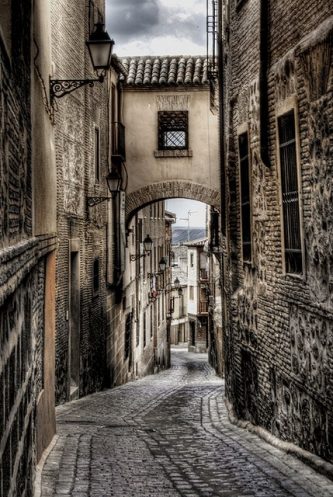ABOUT THIS GUEST POST: Toledo is one of the most beautiful and culturally significant cities in the history of Spain. In his weekly guest post, Aleix will tell us all why…
If Spanish history had to be resumed in one city, that would be Toledo. From Roman times until today, Toledo has been one of the epicentres of Spanish history, seeing or being part of all the main landmark events that this country has seen.
Not only is this city famous for its history but also for its culture, economy and cuisine. A day trip to Toledo is easy from the Spanish capital, because it’s only just over 40 miles from the doorstep of your Madrid apartments, and can easily be reached by car, bus or train.
The city of Toledo is impressive even before you get there. The view of the city from one of the viewpoints on the road into it shows an old town on a hill with the great Alcázar overlooking it and the river Taugus passing through it.
(skyline image courtesy of 7pm.es)

Toledo was an important city since the Bronze Age, being a main commercial centre during Roman times and, after the fall of the Roman Empire, it became the capital of Visigothic Spain. A key city in the Caliphate of Cordoba during the Muslim invasion of Spain, its conquest by the Castilians meant a turning point in the future of the country since it was such an important city to hold.
Toledo was and is a cultural centre, since it was the home of Christians, Jews and Muslims, who coexisted in relative peace until the latter two were expelled from Spain in 1492 by the Catholic Kings. These three religions left a rich legacy in the city, with synagogues, mosques, churches and libraries being part of Toledo’s cultural tour.
(streets of Toledo photography by J. A. Alcaide)
The city of Toledo was also famous for being a centre of study and knowledge before the 15th century, with its libraries and schools being fomented under the rule of King Alfonso X ‘the Wise’ in the 13th century, and it quickly became a place to be for all Spanish intellectuals and artists of the time.
/\/\/\/\/\/\/\/\/\/\/\/\/\/\/\/\/\/\/\/\/\/\/\/\/
Landmarks in Toledo
The city also has some important landmarks, such as the Monastery of San Juan de los Reyes, built by the Catholic Kings, the Cathedral of Toledo finished in the 15th century, and the aforementioned Alcázar, as well as the synagogues, mosques and other small churches in the old town. The Alcázar is the main landmark though, since it was a Roman palace that was restored by King Felipe II in the 15th century and was a building of great Spanish pride.
The building’s reputation has been tainted since the Spanish Civil War, since Franco and his army used it as a bastion and a symbol of uprising against the Republic, but in any case, it’s well worth a visit because the views from it of the city and the river are quite unique.

Toledo is also famous for its steel industry, more specifically swords and knives, which can be bought in the many shops that you can find around the town. Since you probably won’t be able to take them back with you, the shops ship them to your home at affordable prices and buying a steel item from Toledo is part of the city’s tradition.
(San Juan Reyes image courtesy of Toledo Tourism)
The food in Toledo is excellent, and since it’s in the region of Castilla La Mancha, don’t forget to try its famous manchego cheese, one of the best in Spain and Europe. Spanish cuisine and tapas can be found easily in many restaurants or mesones, typical Spanish taverns/restaurants. A must, since eating traditional food in Spain is a large part of the country’s attraction.
Not only do you have many things to do in the city at a stone’s throw from your apartments in Madrid but you also have many day trips from the city that are not just highly enjoyable but also interesting from a cultural point of view. And the food, don’t forget the food!
About the Author: Aleix Gwilliam is a 24 year old from Barcelona who looks English but thinks like a Catalan. He enjoys travelling, especially on old Czech trains, and trying to start conversations in Hungarian with people at Pecs station, even though his Hungarian is as good as his Bulgarian, in other words, not very good. He’s a trier.
EXPLORE SOMEWHERE NEW
Nothing found.
BUY A PRINT
All photos on this site are available as limited edition fine art photographic prints. Please get in touch for sizes and rates.


